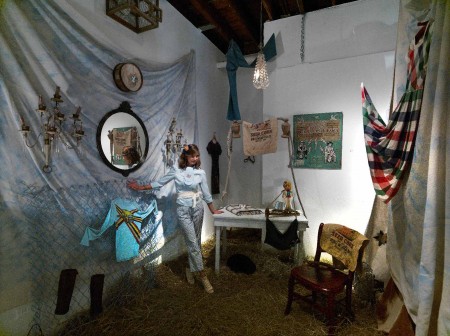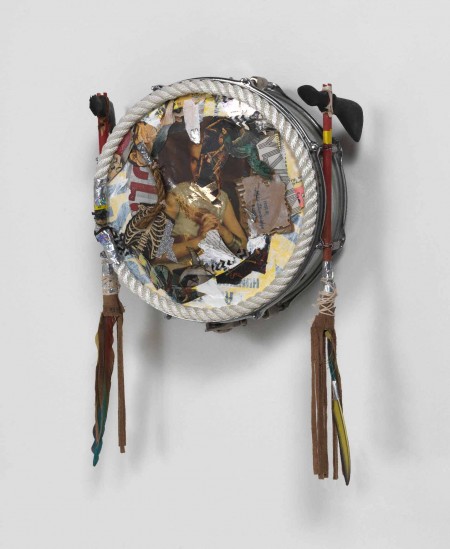Camille Iemmolo’s The Lonely Stage opened at Thomas Master’s Gallery in Chicago on September ninth, and closed on the twenty-third. Importantly perhaps, this exhibition is returning of sorts because Iemmolo’s first solo exhibition was with Master’s some years ago. The exhibit was a collaborative effort between Iemmolo and famed Welsh ex-pat, Chicago painter, musician and songwriter Jon Langford (Mekons, Skull Orchard, The Waco Brothers). Langford’s work has captured my heart for several years now. I would describe each of his scrawled and snarling paintings as spitting libations for rock n’ roll’s unholy rollers, poured out in praising the clandestine truths of record store salvation and the satanic gospels of rock n’ roll. More importantly perhaps, Langford’s work also champions the cause of the workingman via an ethos wrought from Woody Guthrie. This review, despite my great respect for Jon’s work, will focus on Iemmolo.
I first stumbled upon Iemmolo’s sorrowful sojourn perusing the Packer-Schopf Galleries’ archives at the behest of a professor of mine. It immediately jumped out at me as being different in a highly personal way. Her work is honest and subject to sensitivity, very much the product of emotional suffering and deep feeling. Between the Band-aid House she’d constructed of over 26,000 band-aids for her brother Paul (the ultimate sibling love bomb, literally a house of healing), but also a universal message regarding human suffering and how we endure, or her mournfully sweet drawings of horses, I identified a truly earnest impression, and the shadowy weight of empathy. Speaking with Iemmolo on the phone intensified what I already knew as she explained a life swaddled in deep emotions revolving around loss. It seems she is redeemed by gusts of magic, faith, friendship, compulsion, storied objects, and true love.
The Lonely Stage is a part of Iemmolo’s life long working body called The Collector, aptly named as its scope is vast and perhaps also an artistically intentional exercise in curated hoarding. Iemmolo is adept at finding things that respond to her romantic aesthetics. In our conversation Iemmolo explained that she feels connected to people on the way out. She is an empath and a dreamer, and from these wells draws the sultry viscosity of the human legend as pertains to her person and those she loves the most.
Five years ago Iemmolo was thrown from her horse on Friday the Thirteenth, true to the salt of epic heroines she broke thirteen bones and her neck. She related to me that pain holds space in her life, and yet as we spoke she had situated herself under a tree out in the pasture where she was riding her horse despite the pain it causes her now. It would seem cataclysm marks the inspirational energy for much of her work. She cites the loss of her brother and her accident as two such events. Interestingly she holds degrees in business and fashion, but she has been called as an artist as far back as memory goes, for instance, the idea for the Band-aid house originated in her childhood. For a long time she was prone to not making things or destroying art works because she felt guilty producing “widgets in a world of widgets.”

The exhibition was centrifuged around Iemmolo’s installation The Lonely Stage, the title of which frames the creative experience. On opening night that stage was graced with a cavalcade of six old timey musical acts of the country music variety. Being led by the famed and much loved Jon Langford and his talented mates as well as his world renowed Mekons. Other performers included Aron Packer of Sinners Friend Bluegrass Band, The Girls of Golden West with their true roots leading back to the Chicago Barndance, Michel O’Briant of Lonesome Still and singer song writer Randy Russo. Iemmolo’s tribute to radio personality and National Barn Dance legend George “Judge” Hay. Importantly, The National Barn Dance originally broadcasted out of Chicago and later became Nashville’s Grand Ole Opry. Iemmolo’s archivist sensibilities and Langford’s Rock n’ Roll fantasy meshed to form the perfect country music historic phantasm, underlined by a mutual tendency to generate vibrational mythos from the fabrics of countercultures’ anti-hero worship. The interpolation of sound, installation, fashion, and painting made a strong statement. Ultimately Iemmolo wants to take the installation to Nashville, perhaps Grand Ole Opry, no dream too big.

Iemmolo’s work escapes convention meeting human refinement and folk-heroism in wide blue skies of days long gone down. Objects, and her inner magpie meet fine arts at the crossroads of a life lived in fibers of fables. The stage is authentically replete with a hayloft backstage, because we all get the blues sometimes. In this backstage area ghosts are dressed in curated western fashions of the artist’s wardrobe of period fashions and Langford’s suits painted wildly without abandon, hung about the ceiling in taciturn flight. Antique chairs are scattered about painted up in Americana toleware. A chalkware carnival prize chides nostalgia from a desktop and further ghost costumes of barn dance heydays cascade the white walls, weaving in between derelict candelabras, transfiguring the exhibition space into a blue breath of the past.
The installation features a lot of different drumheads, not to mention the kit on stage, which Iemmolo has collected over the years. The drumheads are decorated by Iemmolo to varying degrees. Some of the drums like White Horse Bleeding Beating Banging Heart, are completely covered in Iemmolo’s careful collage. As one might notice from the title, the cadence of a horse is implicated, and from our conversation this meaning is in all of the drums.


Both Iemmolo and Langford exhibited works that cater to more traditional conventions of painting. While Langford’s painting identifies icon and ideal, I think Iemmolo’s work creates presence through absence and amalgam. The paintings are just as much aesthetic gatherings as the rest of the installation is; however the hand is implicit in the surface, as is the artist’s mind expressed in the paintings almost like a diagram. The paintings often feature ready made elements with which they are hung in tandem as in The Telling Tree, or The Cupcake Denials (pictured below with the aforementioned). The Telling Tree is installed before a barber’s pole, and The Cupcake Denials is hung below an architectural element. The paintings surfaces are gridded with string and smattered with textual elements of collage that seem to vary in referential nature, their mystery ultimately marking them of the personal.

In conclusion I’ll say that Iemmolo’s work is made with the deep mark of mannerism, cultivated from an early age and spanning an entire life. Iemmolo’s work is a playground of memory and feeling tied with hope in knots of hardship with lifelines and nooses. Her work is skin scarring and flower blooming bound in sonnets of beauty queens and lone rangers. Her work is honest and authentic because it risks the manna of her heart.
–Jack Wood